Webhook Integration with OAuth v2
Last Update: 2025-04-10
Purpose
This article provides instructions on adding a Webhook integration, a process applicable to both Outscan and HIAB. For illustrative purposes, Jira Cloud is used as an example of a Webhook integration using OAuth.
Introduction
This article explains how to set up Webhook integrations with OAuth 2.0 authentication for Outscan and HIAB platforms, using Jira Cloud’s API v2 as an example for secure connections to external systems. It outlines the need for an OAuth v2-compatible system and walks through the setup process: configuring callback URLs (like https://outscan.outpost24.com/portal/oauth for Outscan or a specific HIAB hostname/IP), creating integrations in the portal, and defining details like the endpoint URL, HTTP method, retry timing, headers, and optional self-signed certificates for secure data transfer. For authentication, enter OAuth details such as Client ID, Client Secret, Token URL, and Authorize URL, plus optional fields like Audience or Scope, choosing the request format based on the third-party system’s requirements. After saving, access authorization is done through a redirect flow, then verify the integration to confirm data delivery and system compatibility.
Requirements
An external system implementing OAuth v2 is required.
Set up OAuth Webhook Integration
The process involves the following steps:
Create an application with OAuth 2.0 on the third-party entity (for example Jira Cloud). Refer to the example provided below for Jira Cloud for guidance.
Set up the callback URL:
For Integration from Outscan:
Callback URL:https://outscan.outpost24.com/portal/oauthFor Integration from HIAB:
Callback URL:https//<HIABHostName|HIABIPAddress>/portal/oauth
Set to HIAB hostname when defined; otherwise, use the HIAB IP address.
Login to either OUTSCAN or HIAB
Go to Portal > Configuration > Integrations view.
Create a Webhook integration by filling in the required parameters and click Save. See Integration Management for more information.
Reopen the newly created integration and navigate to the Authentication tab, select OAuth and fill in the required and optional parameters then and click Save.
Once saved, run the authorize call flow by clicking on AUTHORIZE, follow the directions and grant access to resources.
Once authorized, go to SETTINGS tab and click on VERIFY.
Create Webhook Integration
To add a new integration, follow these steps:
Click on the green
 button located in the lower-right corner of the browser window.
button located in the lower-right corner of the browser window.Select the desired integration configuration type from the drop-down menu.
Fill in the necessary parameters. See Webhook fields overview.
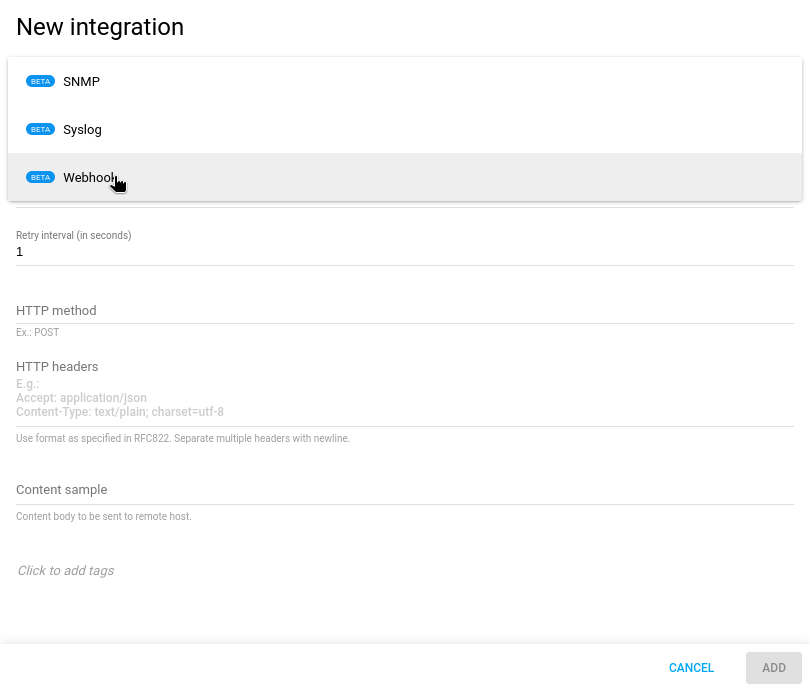
Click Add to finish creating the Webhook integration.
Webhook Fields Overview
Option | Description |
|---|---|
Integration | The selected integration type determines the available fields, which vary based on the chosen integration. |
Name* | Descriptive name of the integration. |
URL* | Represents the web address where Webhook data is sent when specific events occur, facilitating communication between systems or applications. |
Retry Interval | Time duration between consecutive retry attempts that the system makes when there are difficulties in delivering Webhook payloads to the designated endpoint, influencing the timing of retry operations to optimize delivery reliability. Expressed in seconds. |
HTTP Method | HTTP protocol method (e.g., POST, GET, PUT) used for sending Webhook payloads to the specified endpoint, determining the action to be performed when communicating with the remote host. When left empty it defaults to POST method. |
HTTP Headers | Additional information or metadata provided within the HTTP request that accompanies Webhook payloads, conveying details about the data being transmitted and facilitating proper communication and processing between sender and recipient system. |
Password* | Confidential authentication key or secret used in combination with the Username to verify the sender's identity when making HTTP requests to the Webhook endpoint. |
Upload certificate | Digital security credential, often self-signed, that is used to establish a secure and trusted connection between the sender and the recipient of Webhook data, ensuring data integrity and confidentiality during transmission. |
Content Sample | Represents a content sample of Webhook data is used to verify the Webhook integration works. |
Example with Jira Cloud Webhook for creating issue on a project named TEST. Example base on Jira API v2.
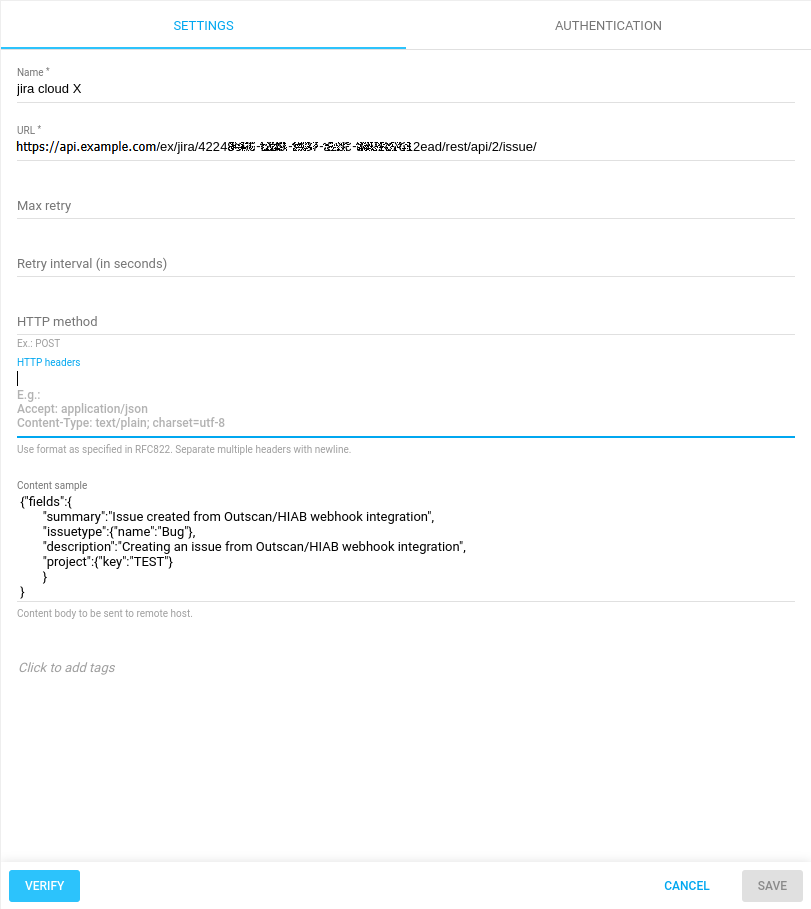
Go to the Authentication tab.
Select OAuth and fill in the parameters.
Client ID: enter the client ID retrieved from the third party entity that you want to integrate with.
Client secret: enter the client secret from the third party entity you want to integrate with.
Token URL: insert the OAuth token URL of the third party you want to integrate with.
Authorize URL: insert here the OAuth authorize URL of the third party you integrate with.
Audience: is optional, check if the third party requires it or not.
Scope: is optional, check if the third party requires it or not.
Set the OAuth API type.
OAuth API type refers to how the authorize and refresh token requests are implemented by the third party your webhook integrates to. It can be set either to application/json or application/x-www-form-urlencoded which respectively either adds parameters at JSON format to request body or adds encoded parameters in the URL. Please refer to the third party documentation to identify which uses case applies.Upload the third party server certificate when self-signed.
Once done, click on Save.
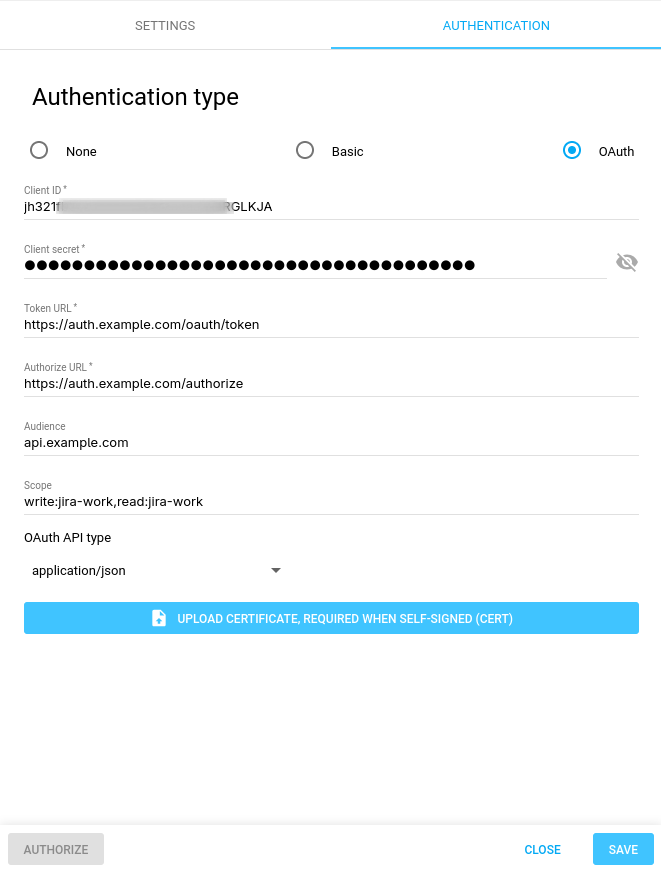
Once saved, run the Authorize call flow by clicking on AUTHORIZE and follow the directions and grant access to resources.
The Authorize call flow continues in getting the authorization to access resources on the third party entity.
The Authorize call flow depends on the third party but works in a similar way:A new window is opened and the third party ask for accepting granting access to the resources.
Upon accept/deny user action, the windows is closed and you are prompted back to the Integration view where you can see the authorization status on the SETTINGS panel.
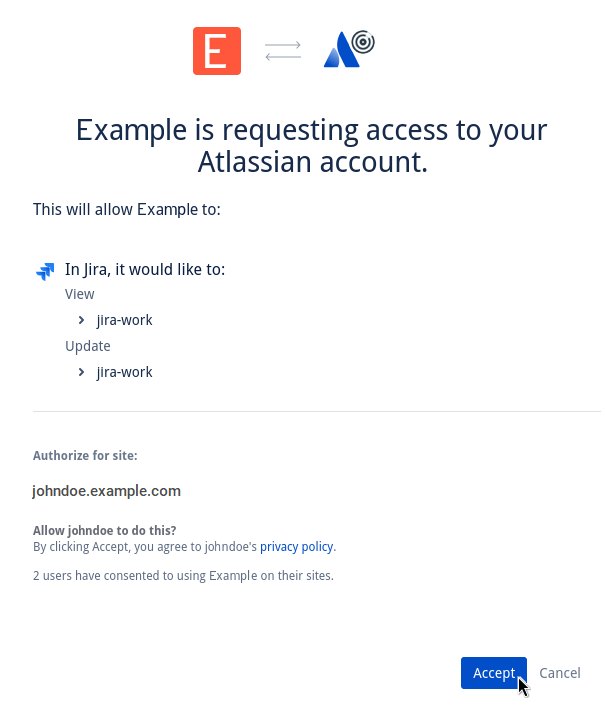
Once authorized, go to SETTINGS panel and click on VERIFY.
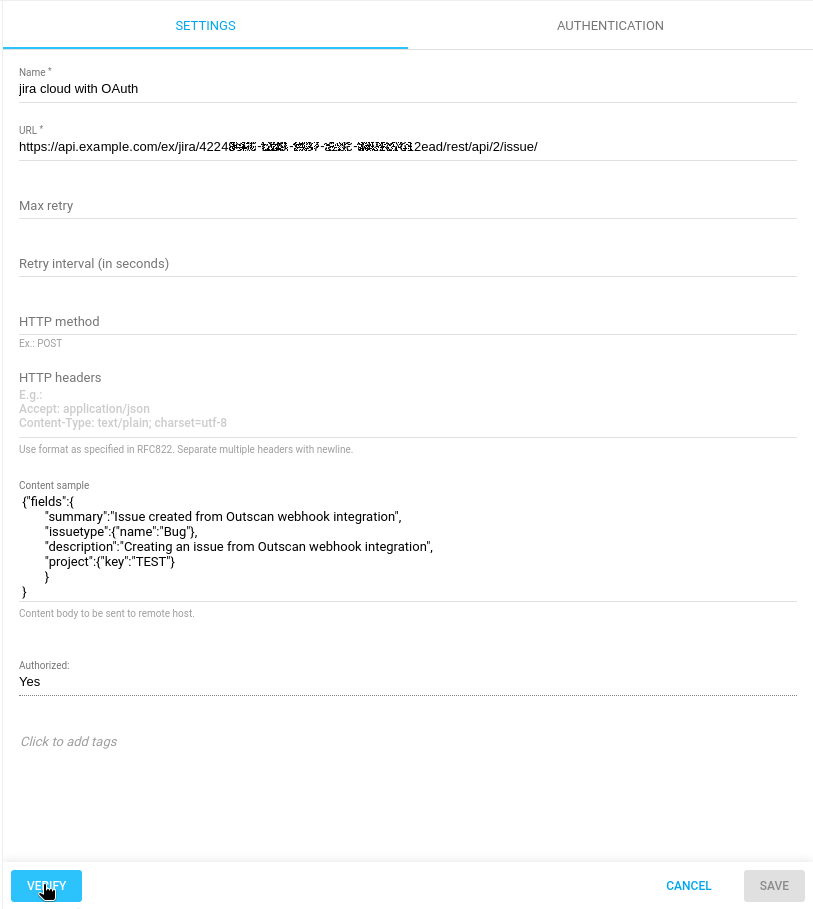
Reference
OAuth 2.0 (3LO) apps: https://developer.atlassian.com/cloud/jira/platform/oauth-2-3lo-apps
Jira Cloud scope: https://developer.atlassian.com/platform/forge/manifest-reference/scopes-product-jira/
Jira API v2: https://developer.atlassian.com/cloud/jira/platform/rest/v2/api-group-users/#api-rest-api-2-user-get
Related Articles
- CyberArk Integration
- Delinea Integration
- General Information about SMB/WinRM Scanning
- Integration Management
- Portal Integration with ServiceNow Incidents
- SNMP Integration
- Syslog Integration
- Webhook Integration
- Webhook Integration with JIRA
- Webhook Integration with Microsoft Teams
- Webhook Integration with OAuth v2
Copyright
© 2026 Outpost24® All rights reserved. This document may only be redistributed unedited and unaltered. This document may be cited and referenced only if clearly crediting Outpost24® and this document as the source. Any other reproduction and redistribution in print or electronically is strictly prohibited without explicit permission.
Trademark
Outpost24® and OUTSCAN™ are trademarks of Outpost24® and its affiliated companies. All other brand names, product names or trademarks belong to their respective owners.
